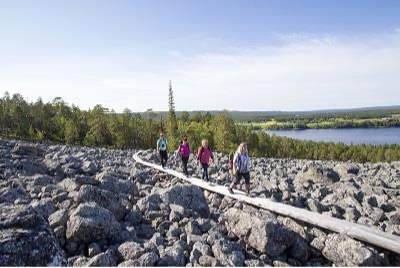Juujärvi

The village of Juujärvi is located about 50 kilometres from Kemijärvi in the direction of Ranua. The village area includes Pikkukylä, Jokelanranta, Juujärvi and Juukoski. The landscape is dominated by the Kemijoki River and the mighty Juuvaara.
The village is one of the few of cultural and historical significance in the area and is classified as a traditional village. The village is a landscape area of national importance, representing the riverside settlement of the central Kemijoki river basin in the Peräpohjola floodplain. Just before the village, coming from Kemijärvi, is the Seitakorva power plant, completed in 1963. It is among the ten largest hydroelectric power plants in Finland.
The village of Juujärvi is a prehistoric settlement area. Objects found during excavations in the area have suggested that it was inhabited as early as 7000 years ago. Until the 17th century, the whole of eastern Lapland was Lapinmaa, an area inhabited mostly by the Forest Lapps, which began to be settled in 1606 and 1610 by orders of King Charles IX. At that time, people made their living from livestock farming and from cereals grown on small plots of arable land. Additional income came from the abundant fishing waters of the Kemijoki and Kemijärvi rivers.
An important step in the settlement of the village was the beginning of the Kemijoki river dredging in the 19th century. It brought new people to the large savottas and the timber trade began. In Kotalahti, there are still some structures left from the time of the rafting. The next factor that strongly influenced the village was the construction of power plants by Kemijoki Oy in the 1950s and 60s. In the Juujärvi and Pirttikoski area, at the peak of construction, there were several thousand workers and hundreds of different types of machinery working on the power plant.
In recent decades, the village’s population has dwindled and services have moved to the centres. The last shop closed in the mid-1980s. The Juujärvi primary school was closed in 1997 at the request of the villagers. The closure of the school was inevitable, and for the well-being of the children the closure and transfer to Pirttikoski school was a better option than moving to Isokylä in Kemijärvi when the secondary school started.
Source: the Juujärvi village plan
Juujärvi Village Association
pj. Marjatta Haavisto 040 5471518, marjatta.haavisto@icloud.com
Secretary Helvi Juujärvi 040 726 8917, helvi.juujarvi@hotmail.com


